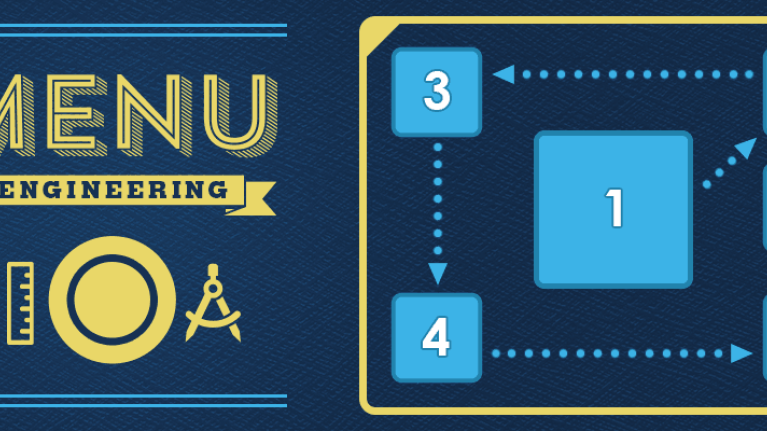
Engineer Your Menu Around Profits
Your menu is a powerful tool for building business. Learn how item placement, category organization, pricing, and design can help improve your profitability.
You’ve heard the term “suggestive selling.” Well, the menu is one of the most effective tools you have for selling what you want customers to buy, whether that is your most profitable items or their most nutritious choices. As a recent article in The Atlantic explains, a good menu is not only a sales document but also a navigational tool and a kind of dictionary to what you are offering.
The design, layout, and writing of a menu will affect what people order, and how much they spend. This is called menu engineering or menu optimization. Part art and part science, menu engineering is based on the idea that customers read menus in certain predictable orders (for instance, the location of elements on a page), are attracted to certain features (such as boxes or photos), and are influenced by certain factors (including prices and how an item is named or described). A Pizza Hut test program in the U.K. even suggests orders based on tracking customers’ eye movements across the menu board.
Whole volumes have been written on the subject of menu psychology and optimization, but here are a few basics:
-
First, Crunch the Numbers – In order to sell, say, your most profitable menu items, you need to know what they are. According to back office system provider CrunchTime, you need a thorough understanding of the sales volume, ingredient cost, and menu categorization of each item on your menu in order to assemble the proper data set for analysis before you can start a meaningful menu engineering project. If this is a new menu, you are going to have to give it your best educated guess to get the ball rolling.
-
Menu Engineering 101 – Generally speaking, most menu items fall into one of four basic categories: stars (high profitability and high popularity; workhorses (popular items that are not that profitable); dogs (low in both popularity and profitability); and puzzles (profitable items that don’t sell very well). You want to:
-
Sell as many of the stars as possible
-
Figure out a way to sell more of the puzzles
-
Reduce the sales of the workhorses (which you can’t eliminate altogether—they’re too popular!)
-
Get rid of (or at least bury) the dogs
-
Place Menu Items Strategically – The vast majority of patrons read menus the same way: On a one-page menu, they look at the first few items at the top, then skip to the bottom, then return to the middle of the page. On a two-page menu, diners start at the top right, then move to the top left, then to the bottom right, and on to the middle. Position your best items (most profitable, lowest food cost, etc) in those areas where the eye naturally comes to rest, which many menu designers refer to as a “hot zone,” such as the center of the page first. This is also where you should locate the healthy choices you want your customers to order more of.
-
Getting Graphic – Boxes (shaded or outlined), type and color changes, photos, and other graphic treatments draw the eye; use these devices to highlight high-profit items or other dishes that you want to sell more of.
-
Don’t Organize by Price – Never place items ranked by price; mix it up to get the customers focus off the cost and on the description of the dish. By the same token, don't right justify prices on the menu—they stand out too much. Tuck the price in at the end of the description, where it will tend to disappear. Also, use a slightly smaller font for prices, since numerals in the same font appear larger than letters.
-
Note on the $: According to a study by The Center for Hospitality Research at Cornell University, on average, customers spent 8% more when prices were in numerals with no dollar sign (20) versus in dollars and cents ($20.00) or written out (twenty dollars), because they were not focusing so much on money
-
The website Urban Spoon has posited that menus that list prices in a neat column down the right side allow customers to compare prices and pick cheaper items. Upscale restaurants will put the price immediately next to the dish, in the same typeface font as the description, so it's harder to distinguish each item's price
-
Use Your Words – The way you describe menu items will influence how customers choose them. Certain buzzwords, like “fresh” and “local,” really appeal to guests, according to research from Culinary Visions Panel; so do qualities like fair trade and heirloom (as for fruits and vegetables).
-
Provide Information (But Not Too Much) – Nowadays, customers want to know where their food comes from, how it’s prepared, and how it will taste. Call out the name of the farm your vegetables come from, and the fact that they’re roasted and flavored with a complex blend of Moroccan spices. Just don’t bog readers down with so much information—or so many choices—that they get overwhelmed. In fact, evidence suggests that many chains are actually shrinking the number of menu items they are offering.
-
If you offer items that are vegetarian, gluten free, or address other special dietary needs or preferences, make sure customers can identify them—whether it’s with a symbol, description, notation, or even a special menu section
-
Keep it Clean, and Legible – That means a type size that’s large enough and dark (or contrasty) enough to stand out against the background, and avoid cursive or overly elaborate fonts. Also, avoid all capital letters except for the very shortest runs of letters (such as the heading DESSERTS).
-
Ditch menus that are dirty, stained, crumpled, or otherwise compromised
-
Specials Get a Menu – If you offer more than a few daily or weekly specials, it’s helpful for customers if they are printed up, either on a sheet/tent or a blackboard, rather than being recited by a server. And absolutely include the price, so there are no surprises.
-
However, by the same token, don’t have so many different menus (bar menu, lunch menu, specials menu) that your customers can’t follow along
-
Online, In Sight – Pay attention to the menu on your website too. Fast Company has gushed about the appeal of McDonald’s Full Menu Explorer, in which the entire menu is laid out on one online page. In general, if at all possible, keep a reasonably current menu on your website, including prices. Try to offer your menu in a pdf format so customers can print it out and study it or pass it along; include the name of the restaurant and contact information in case the menu finds its way into completely different hands.
